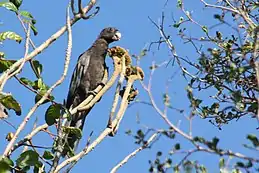Lesser vasa parrot
The lesser vasa parrot or black parrot (Coracopsis nigra) is a black coloured parrot native to Comoros, Madagascar, Mayotte, and Seychelles.[1] It is one of two species of vasa parrots, the other being the greater vasa parrot C. vasa; although, the subspecies C. n. barklyi, of the Seychelles, is sometimes split as a third species, the Seychelles black parrot.[2]
| Lesser vasa parrot | |
|---|---|
 | |
| Coracopsis nigra in Anjajavy Forest, Madagascar | |
| Scientific classification | |
| Kingdom: | Animalia |
| Phylum: | Chordata |
| Class: | Aves |
| Order: | Psittaciformes |
| Family: | Psittaculidae |
| Genus: | Coracopsis |
| Species: | C. nigra |
| Binomial name | |
| Coracopsis nigra | |
| Synonyms | |
| |
Lesser vasa parrots inhabit the mangrove swamps and evergreen forests of Madagascar and the Seychelles Islands. They eat seeds, blossoms and fruit - especially berries and mangos.
They build their nests in tree hollows and go through courtship in February. During this time, the female may shed the feathers on her head giving it a yellowish tone. The male's beak may also turn white during this time.

Taxonomy
The lesser vasa parrot was one of the many species originally described by Carl Linnaeus in his 1758 10th edition of Systema Naturae; it was given the name of Psittacus niger,[3] meaning "black parrot". It was later transferred to the new genus Coracopsis in 1826.
There are three or four subspecies depending on classification systems:
Coracopsis nigra sibilans and Coracopsis nigra barklyi are considered a single subspecies by some authors.
A 2011 genetic study found the Mascarene parrot from Réunion to be nested among the subspecies of the lesser vasa parrot from Madagascar and nearby islands, and therefore not related to the Psittacula parrots. It also found that the Mascarene parrot line diverged 4.6 to 9 million years ago, prior to the formation of Réunion, indicating this must have happened elsewhere.[6] The cladogram accompanying the study is shown below:
E |
| ||||||||||||||||||||||||||||||||||||
Another group of scientists later acknowledged the finding, but pointed out that the sample might have been damaged, and that further testing was needed before the issue could be fully resolved. They also noted that if Mascarinus was confirmed to be embedded within the genus Coracopsis, the latter would become a junior synonym, since the former name is older.[7] Hume has expressed surprise by these findings, due to the anatomical similarities between the Mascarene parrot and other parrots from the islands that are believed to be psittaculines.[8]
References
- BirdLife International (2012). "Coracopsis nigra". IUCN Red List of Threatened Species. 2012. Retrieved 26 November 2013.CS1 maint: ref=harv (link)
- "Foudia sechellarum Seychelles Fody Foudi des Seychelles", The Birds of Africa: The Malagasy Region, Christopher Helm, 2013, doi:10.5040/9781472927040.0484, ISBN 978-0-7136-6532-1
- Linnaeus, Carl (1758). Systema naturae per regna tria naturae, secundum classes, ordines, genera, species, cum characteribus, differentiis, synonymis, locis. Tomus I. Editio decima, reformata (in Latin). Holmiae. (Laurentii Salvii). p. 824. Archived from the original on 2015-03-19.
- "Zoological Nomenclature Resource: Psittaciformes (Version 9.020)". www.zoonomen.net. 2009-03-01.
- Juniper, Tony; Mike Parr (1998). Parrots: A Guide to Parrots of the World. Yale University Press. ISBN 978-0-300-07453-6.
- Kundu, S.; Jones, C. G.; Prys-Jones, R. P.; Groombridge, J. J. (2011). "The evolution of the Indian Ocean parrots (Psittaciformes): Extinction, adaptive radiation and eustacy". Molecular Phylogenetics and Evolution. 62 (1): 296–305. doi:10.1016/j.ympev.2011.09.025. PMID 22019932.
- Joseph, L.; Toon, A.; Schirtzinger, E. E.; Wright, T. F.; Schodde, R. (2012). "A revised nomenclature and classification for family-group taxa of parrots (Psittaciformes)". Zootaxa. 3205. 3205: 26–40. doi:10.11646/zootaxa.3205.1.2.
- Hume, J. P.; Walters, M. (2012). Extinct Birds. London: A & C Black. pp. 177–178. ISBN 978-1-4081-5725-1.

